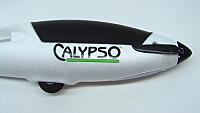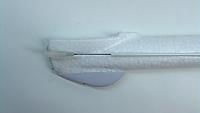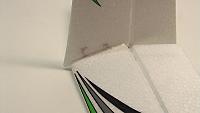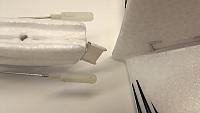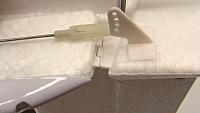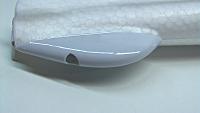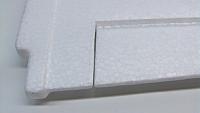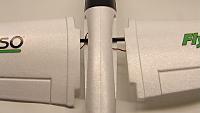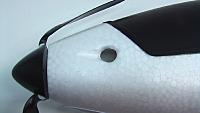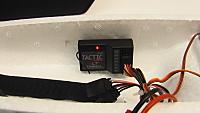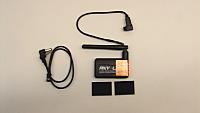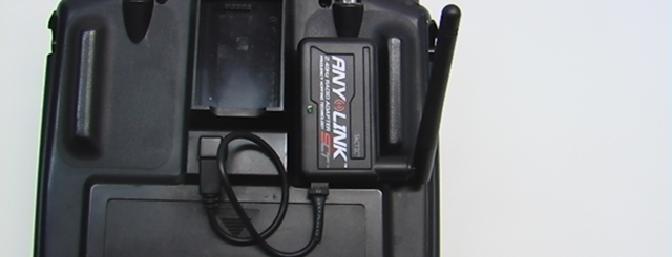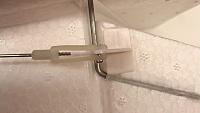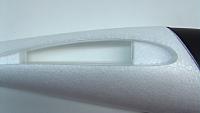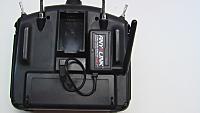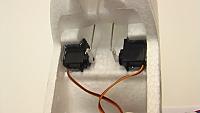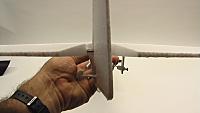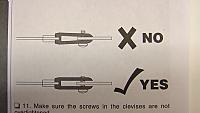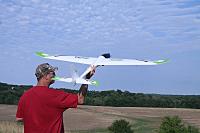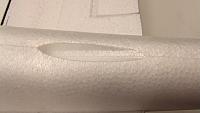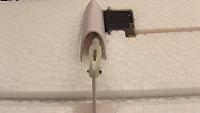|
|
||||||||||||||||||||||||||||||||||||||||||||||||||||||||||||||||||||||||||||||||||||||||||||||||||||||||||||||||||||||||||||||||||||||||||||||||||||||||
|
Thread OP
|
Flyzone 73" Calypso EP Glider ReviewIntroduction
Flyzone’s 73” Calypso EP glider comes in four versions: Rx-R receiver ready (includes servos, ESC and brushless motor), RTF with Tactic TTX404 transmitter, ARF allowing the customer to use their own equipment (ARF Manual) and this version reviewed here, the Tx-R transmitter ready glider. In the transmitter-ready configuration a 6-channel SLT 2.4 GHz. Tactic receiver is installed awaiting the bind using either a Tactic 2.4 GHz transmitter or via the new Tactic AnyLink SLT 2.4 GHz. Universal radio adapter to most major brands of radios. This is a beautiful aircraft with a bright, easy to see color scheme. Constructed of Aero-cell foam (EPO and CA safe), you get a smooth flying surface that is perfectly molded and almost indestructible. In the transmitter-ready version the Calypso takes only about 30 minutes to build with no glue necessary. When complete, this is a remarkable glider that can follow a pilot’s lead to slope or thermal lift and stay there. Flaps are an option that require the installation of servos, control horns, servo leads and some cutting of the aileron to create the inside flaps. Flap kits will be available very soon from Flyzone or you can improvise your own setup. My experience tells me this will be a no-brainer option since getting the Calypso to release its grip on lift is not easy. The Calypso wants to fly and does so in all types of wind. This is a plane that will not be denied flight on those windy days.
Kit Contents
My Calypso arrived with no damage. Each item was packaged in bubble wrap to protect it from shipping rash. There were no loose items that could cause damage. The battery charger and one small accessory bag were taped to the box interior. I'm not sure if this was intentional, but the length of the box provides some extra room for crushing on the ends should that occur. The wings are separated within the box and stabilized with tape. All in all, this was a very well designed shipping container and packaging.
Assembly
Assembly just means that you install the tail, slide the wings together and setup the electronics. Because this is a Tx-R product you will need to bind your radio.
Tail
There are two components to the tail that need to be installed. Both the horizontal stabilizer and vertical stabilizer are secured with one bolt. Before you start putting things together, make sure to flex the rudder and elevator at least 100 rotations to free up the hinges and lessen the torque required by the servos. As you flex the control surface you will realize they get easier to flex. I would guess there are thousands of flex cycles so these are never going to wear out.
The tail build is a one-two-three process with a tight, very well designed and molded component set.
Wing
The Calypso’s wings are huge and provide incredible lift. Once you fly the Calypso you will see what I mean as this plane prefers to be in the air rather than on the ground. The wing is two-piece with a carbon spar. One unique feature is the locking bolts under the wings that keep the wings together. The only build process is to install the spar, slip the wings halves together, tighten the locking bolts and connect the aileron servos to the receiver. Nice design.
Fuselage
The fuselage is perfectly molded and straight. It is 47” long, so you get some great flight stability from the length. The fuselage is also streamlined with a large area for electronics, and a huge magnetically attached canopy with a perfectly sculptured transition to the tail. All the linkages are housed in plastic sleeves with a bolt secured clevis. A huge wheel under the cabin keeps the Calypso from damage on landing off of any surface.
Radio Installation and the Tx-R AnyLink
The bind was without anything unusual, and by following the directions I easily connected my Futaba 9C Super using the provided cable to the onboard Tactic receiver. It was bsolutely seamless. To my advantage I was able to set all the parameters necessary for flight and mix the tail to the ailerons. Dual rates and expo were also a part of the setup so having my trusty 9C in my hands made the experience much more user-friendly. Here is a link to more information on the AnyLink Addendum.
I centered all my transmitter sticks and adjusted the control surfaces. I did notice the clevises were very tight on the control rods, and to avoid twisting the linkage I had to use pliers to hold the steel linkage until they loosened up a bit. I used the settings provided in the instructions in degrees, mm and inches. Flyzone recommends calibrating your throttle stick. This applies to Rx-R and Tx-R versions. This is a simple process that ensures your ESC and throttle are synchronized. A range check is appropriate with any changes in your radio setup.
Take your time centering the control surfaces, and make sure to not over tighten the clevis. Do not just insert the clevis into the outer hole as the elevator. The first flight setting is in the third hole, not the outer hole.
Flying
The Calypso is a flying machine. It is a powered glider, but it is fully capable of gliding. Don’t expect that to be the case with all powered gliders. You know the minute you chop the throttle if the plane will glide, and I assure you the Calypso is an excellent soaring airplane. On the day I took the video I was flying in 30mph gusts at 105 degrees (density altitude at nearly 4,000 feet) and I could still literally hover the Calypso into the wind. Lift is strong, and the wind penetration is excellent. Even in cross-winded turns I did not feel as though the plane wanted to roll over. I was always in quick and authoritative control. Overall, the stability is wonderful and even in heavy cross winds and gusts it is easy to control. Under power, the Calypso tracks straight and has almost vertical performance. I want to install an altimeter and see just how high I can get.
Basics
The Calypso performs, as a glider should. It can ride lift and handle a great deal of wind from either thermals or slope. Stalls are difficult to induce, but in a very steep and slow climb it will stall. The nose drops pretty fast, so make sure you either have some wind or some airspeed on approach or it could stall. An example of a stall is about a third of the way into the video. Because the wings are so big and generate so much lift I did not experience a tip stall, but rather a full-on straightforward nose drop. It was easy to resolve; as soon as some airspeed is generated the stall is over. Power is plentiful. Kick the throttle and pull back the elevator and the Calypso will climb like a rocket. The instructions provide that there should be enough battery power to make at least five climbs. If you have some lift, the separation between those climbs could be a long time. Bring a chair and a bottle of water and prepare for some great soaring.
Taking Off and Landing
A slight hand release is all that is necessary to the get the Calypso in the air. Climb out is strong and no need to be quick to the sticks. Landings require a long final approach and on occasion I found it necessary to disregard all flight rules and land downwind. The lift with even a slight breeze just keeps the plane from wanting to land. You will notice in the video I actually come in across the runway into the wind at almost a hover to land. Landing roll out was almost zero into a 20+mph wind. Flaps will be a great addition.
Aerobatics/Special Flight Performance
Aerobatics are limited to loops and some inverted flight. The wings tend to negate even the most aggressive aileron input to get a good roll going. I suppose if you want to prove something the Calypso will make a big roll. Be careful with inverted flight. Getting upside down is not difficult as you are inverted at the top of the loop, but when getting out of the loop, the Calypso wanted to nose down to come out rather than climbing to push the nose up while inverted. Make sure you have some air under the plane before going inverted. Rolling out is slow.
Is This For a Beginner?
I love training new pilots with gliders. They are forgiving and stable platforms for learning to fly. I would say beginners would enjoy the Calypso because as a parkflyer, this is one fun airplane. It is also a plane that one can fly and then hand the transmitter over to a new pilot. With some altitude the changes are slow and easy to overcome even after getting the transmitter back. All levels of flyers will enjoy the Calypso. Beginners that are learning to fly, but not skilled at finding thermals and lift, will still get several climbs at full throttle and flights of maybe 30 minutes. Those that do find lift and perhaps opt for a larger capacity battery can fly as long as their thumbs can stand it. If you do find lift, get comfortable and enjoy an afternoon of flying. Flaps add a whole new experience. When available from Flyzone or on your own you can really slow the Calypso down. A slight use of the flaps can also increase your lift in light winds. The build instructions are provided in the instructions and designed to be connected via a “Y” connector into one receiver channel.
Flight Video/Photo Gallery
Downloads
Some flight time with the Calypso 17.98 MB
Conclusion
This has been a fun project. I was unsure of how good the Calypso could be until I let it out of my hands on that first launch. In short order, I fell in love with the power curve, glide slope and color scheme. It is a plane I think you will appreciate for how you will get better at flying and soaring. I also really think being able to easily remove the tail and wings makes for a portable big plane that fits back into the box for transportation. That is a nice feature. Keep the bubble wrap for transporting. I would guess in a few assemblies at the park one will become very adept at quickly putting the Calypso together for a flight. I would like to also add the fuselage cavity is huge and I can’t wait to mount a camera on a pan and tilt. Purchase another canopy and a streamlined camera platform would be easy to develop. I think the load handing could be pretty good as the wing loading is very low so either a bigger battery (2100 mAh has been tested) or some camera equipment is just waiting for the possibilities.
ImagesView all Images in thread
|
|||||||||||||||||||||||||||||||||||||||||||||||||||||||||||||||||||||||||||||||||||||||||||||||||||||||||||||||||||||||||||||||||||||||||||||||||||||||
|
Last edited by Angela H; Jul 09, 2012 at 01:07 PM.
|
||||||||||||||||||||||||||||||||||||||||||||||||||||||||||||||||||||||||||||||||||||||||||||||||||||||||||||||||||||||||||||||||||||||||||||||||||||||||
|
|
|
|
|
|
|
Very interested in this motorglider. Also looking at the Radian. Wanting to get back to my sailplane roots without highstart/winch (arthritis). I have been burned before being an early adopter of Flyzone planes. As they say "third times a charm". I'm such a sucker for good looks.

|
|
|
|
|
|
|
|
|
Great review! I've been waiting for a review on this one. Since it is rare for this area to have a wind-free day, I've been thinking of getting a glider. This review has sold me on the calypso.
...lobe |
|
|
|
|
|
|
|
Thread OP
|
Just a little outside the other flyzone planes I have flown. This is a huge stable and powerful flyer. I love the lines. It would have been easy to mold the fuselage straight, but instead it has a slight drop to the tail from the bulbous but streamlined cockpit. Just very pretty lines I think. I also hope to get the flaps up and running soon.
|
|
|
|
|
|
It's a cool plane but a MSRP of $159 for the receiver ready (RxR) version is a little pricy.
|
|
|
Last edited by IIIHorseman; Sep 05, 2012 at 08:05 PM.
|
|
|
|
|
|
Yes the lines are great. It's just plain sexy looking and sex sells!
|
|
|
|
|
|
||
|
|
Quote:
$159.99 |
|
|
|
Last edited by george@dream-flight; Jul 13, 2012 at 10:22 AM.
|
|
|
|
|
|
|
The release is staggered. The TXR and RTF will arrive here shortly in July.
The RxR and ARF will follow. thanks. |
|
|
|
|
|
||
|
|
Quote:
Champaign, IL Joined Oct 2004 453 Posts I know for a fact Champaign, IL is not 1573 miles from Paducah, KY unless you go by way of Atlanta...  When will the Flap kit come and at what price? Saw the flap linkages for $2.25. That can't be all that's needed? Two servos and extension/s? Comes as a "kit" as noted in the review. |
|
|
|
Last edited by gentle ben; Jul 13, 2012 at 08:51 PM.
Reason: Some more questions.
|
|
|
|
||
|
|
Quote:
http://leaderhobby.com/product.asp?I...Location=MIAMI |
|
|
|
||
|
|
||
|
|
Quote:
|
|
|
|
||
|
|
|
|
|
It's not shipping from outside the US, if you didn't notice, this model is at their Miami Florida warehouse, they have 2 US warehouses with different stock at each location, so shipping would be no more or no less than a model this size would cost from FL to KY for you.
|
|
|
|
| Thread Tools | |
| Similar Threads | |||||
| Category | Thread | Thread Starter | Forum | Replies | Last Post |
| Discussion | Flyzone Calypso | george@dream-flight | Electric Sailplanes | 143 | Apr 27, 2017 11:09 AM |
| For Sale | Flyzone cessna 182 ep rtf 2.4 radio | mike robson | Aircraft - Electric - Airplanes (FS/W) | 3 | Apr 07, 2012 08:23 PM |
| Discussion | How to set up and trim an EP glider | JJ460 | Electric Sailplanes | 2 | Mar 24, 2012 08:27 PM |
| Wanted | Wanted, Electric flightnose cone for Calypso contest F3B glider | graham johnson | Aircraft - Electric - Airplanes (FS/W) | 0 | Dec 06, 2008 05:35 PM |



